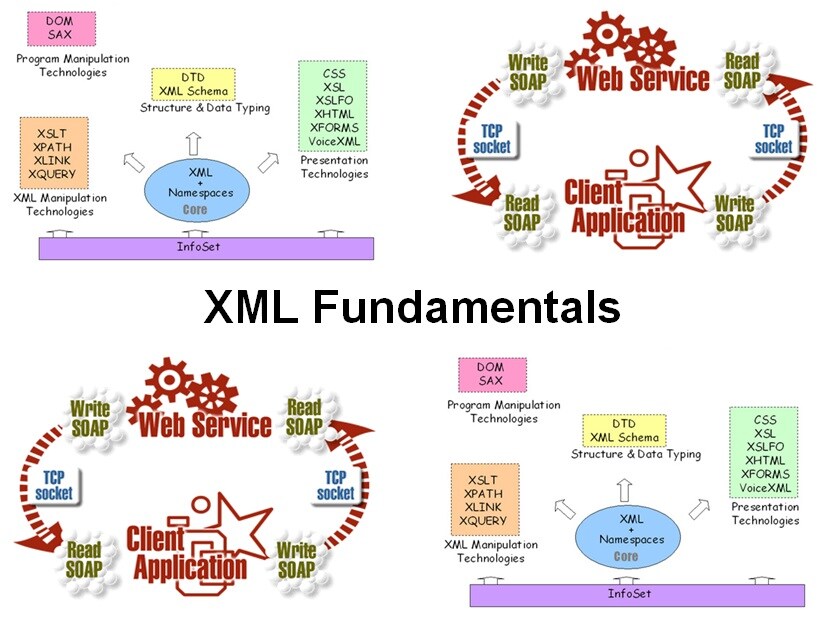-
Learning by doing
-
Trainers with practical experience
-
Classroom training
-
Detailed course material
-
Clear content description
-
Tailormade content possible
-
Training that proceeds
-
Small groups
In the course XML Fundamentals participants will gain a thorough understanding of the fundamentals of XML. The concepts of the meta language XML are discussed as well as the usage of XML.
Attention is paid to the syntax of XML documents and to the difference between well-formed and valid XML documents.
The role of Document Type Definitions (DTDs) and XML Schema's (XSD files) is discussed as well as the importance of several derived XML languages, so called XML vocabularies, is explained.
Also the different ways to present XML documents is covered. In this respect the focus is on the use of eXtended Stylesheet and Transformation Language (XSLT) style sheets and the XPath language to locate and address certain parts in an XML document.
The XQuery XML standard for accessing XML and relational data stores is covered and the syntax and practical applications of XQuery are explained.
Also attention is paid to Web services for exchanging data between heterogeneous distributed systems and related standards such as SOAP and WSDL.
Finally the access of an XML document from a programming language with the DOM and SAX API is discussed. Possible follow-up courses are XSLT Stylesheet, XML Schema and XQuery.
The course XML Fundamentals is designed for project managers, system analysts, application developers and system administrators who want to learn the fundamentals of XML and how and where XML can be used.
To attend this course basic knowledge of the Internet and HTML is required. Knowledge of databases and object oriented programming is beneficial to the understanding of the subject matter.
The theory is covered using presentation slides. Demos are used to clarify the theory. There is ample opportunity to practice.
Participants receive an official certificate XML Fundamentals after successful completion of the course.

Module 1 : XML Introduction |
Module 2 : XML Syntax |
Module 3 : XML Validity |
|
What is XML? XML versus HTML Structured Documents Roots of XML XML Standard Markup Languages XML as Meta Language Benefits of XML XML Technologies Applications of XML XML Validation with XML Schema XML Presentation with Stylesheets XML Transport with Web Services |
XML Document Structure Node Tree XML Prolog XML Elements XML Attributes Well Formed Documents Valid Documents Processing Instructions Entity References CDATA Sections Character References Comments Namespaces |
Document Type Definition DOCTYPE Declaration Internal and External DTD Element Declaration in DTD Attribute Declaration in DTD XML Schema as DTD Successor DTD to XML-Schema Conversion XML-Schema Vocabulary XML Schema Namespace Referencing XML Schema’s Simple and Complex Types XML Schema Data Types User Defined Data Types |
Module 4 : XML Formatting |
Module 5 : XQuery |
Module 6 : XML Programming |
| Separate Content and Presentation What is XSL? XSLT Stylesheets How does XSLT work? What is XPath? Stylesheet Blueprint Templates xsl:value-of xsl:for-each xsl:if Using Predicates Applying templates XSLT as Transformation Language |
What is XQuery? XQuery Processing Model Types of Queries Where is XQuery used? XQuery and other Technologies Basic Syntax Rules Selecting Nodes XPath Expressions FLWOR Expressions Structure of an XQuery Module XQuery Functions Element Constructors Conditional Expressions |
XML Processing Options The XML DOM Building a DOM Tree Node Interface Model XML Access through DOM Navigation and Manipulation Simple API for XML SAX Callbacks XML Parsing Models Pull Parsing versus Push Parsing What is JAXB? JAXB Architecture JAXB Binding Life Cycle |
Module 7 : XML Web Services |
||
| What is a Web Service? Role of Interface Interoperability Web Service Stack RPC Style Web Services Document Style Web Services What is SOAP? SOAP Structure SOAP Message SOAP Messages as Payload SOAP Header What is WSDL? Basic Structure WSDL WSDL and Code generation Service Orientation WS Standards Overview |
